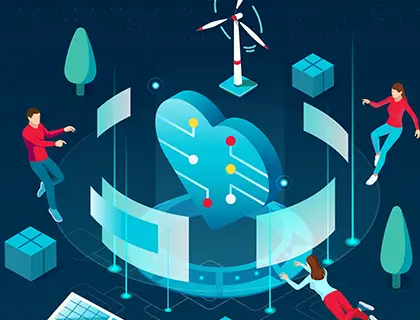
Sustainable businesses in the financial sector are tech-enabled and quantum-secure. They are driven by tech-literate employees and have secured a future where skill gaps do not hinder progress. Their future is certain because their operations are robust against cyber threats.
5 Mins
17th September 2024
Article
Sustainability, Digital transformation
Banking is increasingly becoming a digital-only service with sophisticated products aimed at the self-management of financial assets. Customers are provided with on-demand access to services and triggers for next-best products designed to improve their financial standing.
This customer-centric view is only part of the story. The tech deployment behind the scenes enables financial service providers to serve increasingly nuanced customer segments and operationalise financial opportunities, such as investments, instantly.
Digital transformation is having such a wholesale impact on financial services that the integration of technology is considered to be one of the top challenges and opportunities for the sector in 2024.1
As banks race to stay competitive among their digitally enabled peers, showpiece products such as crypto and blockchain become differentiators and marketable indicators of the institution’s tech literacy.
Each digital touchpoint introduces new risks and potential for financial scams. In Singapore alone, there were 50,376 scam cases in 2023 – a 49.6% increase in just one year. $651.8 million was lost to scam cases in 2023.2 Map the scale of that risk to global operations and that risk becomes untenable.
With risk comes opportunity, and for the financial services sector, that opportunity lies in the form of technology partnerships. The threat landscape for banking has evolved beyond the image of the balaclava-wearing bank robber; it now includes multiple, dispersed, and organised hacker groups. Only tech industry providers can keep pace with these threats and outwit the hackers before they drain bank accounts.
Products like SingVerify are designed with these threats in mind. Using APIs, SingVerify authenticates digital identities registered on consumer services or platforms against telco data. This adds new verification layers to reduce threats and ease the burden of authentication on users.
Providers can not only ensure that customers' identity data matches what they have on file but also offer a seamless customer experience with fewer verification steps. This process will extend beyond borders thanks to a partnership with AIS and Maxis, which aims to verify identities across the ASEAN region. For financial service providers, this means they can offer cross-border products with the same robust and secure customer experience as their core offerings.
The growth in digital services has created a tech-literate workforce in the banking sector, and the demand for these skills has kept pace. Ninety percent of banking employees believe that increased digital skills will aid their company’s adoption of new technology.3
UOB is a leader in driving a tech-first revolution with its co-produced cyber education programme, “Defence Against Cyber Scams.” This scheme upskills UOB’s 1,000 frontline branch staff in preventing, detecting, and resolving scams. Direct and face-to-face contact with customers also enables frontline staff to assist customers in becoming cyber detectives, thereby adding multiple detection layers to the bank’s cyber security strategy.
McKinsey estimates that when the first fault-tolerant quantum computer becomes available, it could generate up to US$622 billion in value for the finance sector.4
While the sector relies on encryption keys to protect data and create secure gateways, the advancement of quantum computing poses a significant threat. Current encryption methods would take today’s conventional computers about 300 trillion years to crack, but a quantum computer powered by 4,099 qubits could accomplish this in just 10 seconds.5
Protecting assets today with a quantum-safe network will mark a watershed moment for financial services when quantum computing arrives. Since secure connectivity is foundational to digitalisation, quantum-safe networks will enable banks to leverage these opportunities without introducing new threats.
Tech-driven innovation is not new to the banking sector. Machine learning and natural language processing (NLP) techniques have been used to automate trading, modernize risk management, and conduct investment research.6
What is new is the evolving threat landscape. As banks engage with tech innovators, they must also partner with cyber security specialists who have a telecommunications advantage. These partnerships will empower their workforce and prepare them for a quantum future. Without this deep tech and telco experience, the financial sector risks entering a growth phase without the necessary safeguards.
Through continuous growth, the financial sector can remain sustainable. Harnessing technology to deliver better, more secure services will surpass peers, and building an educated workforce will help bridge the skills gap of tomorrow.
References:

Sustainability

Sustainability, Transportation, Smart cities

Sustainability, 5G, Manufacturing and logistics

Sustainability

Sustainability, Artificial intelligence and machine learning, Quantum computing

SD-WAN, Sustainability, Artificial intelligence and machine learning, IoT
Get the latest digest on business and technology trends straight to your inbox.